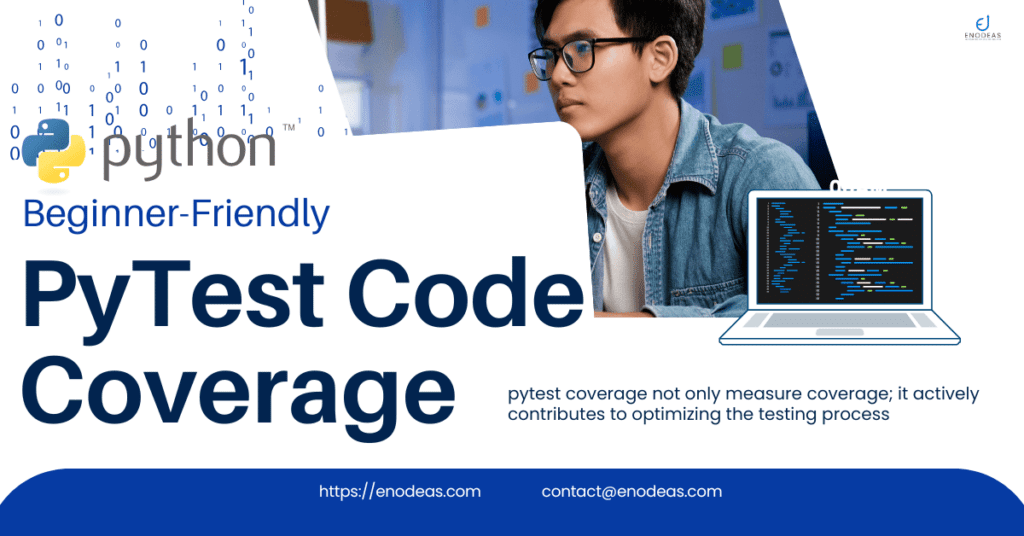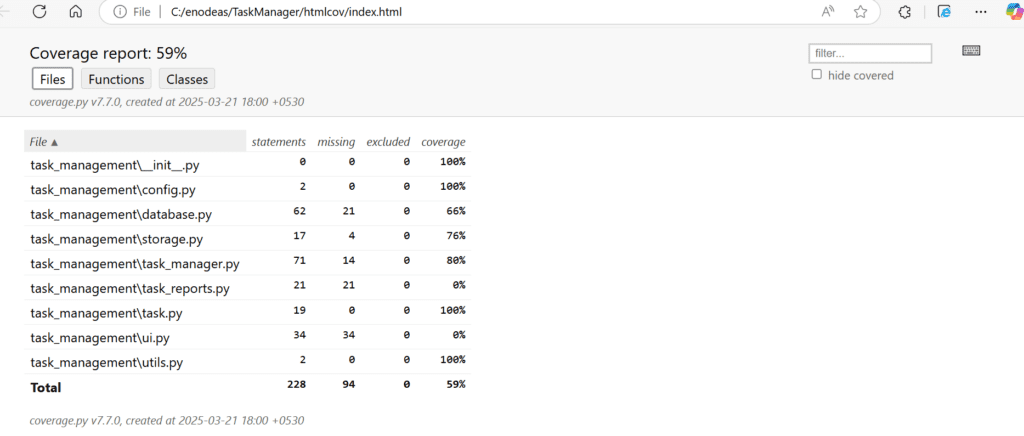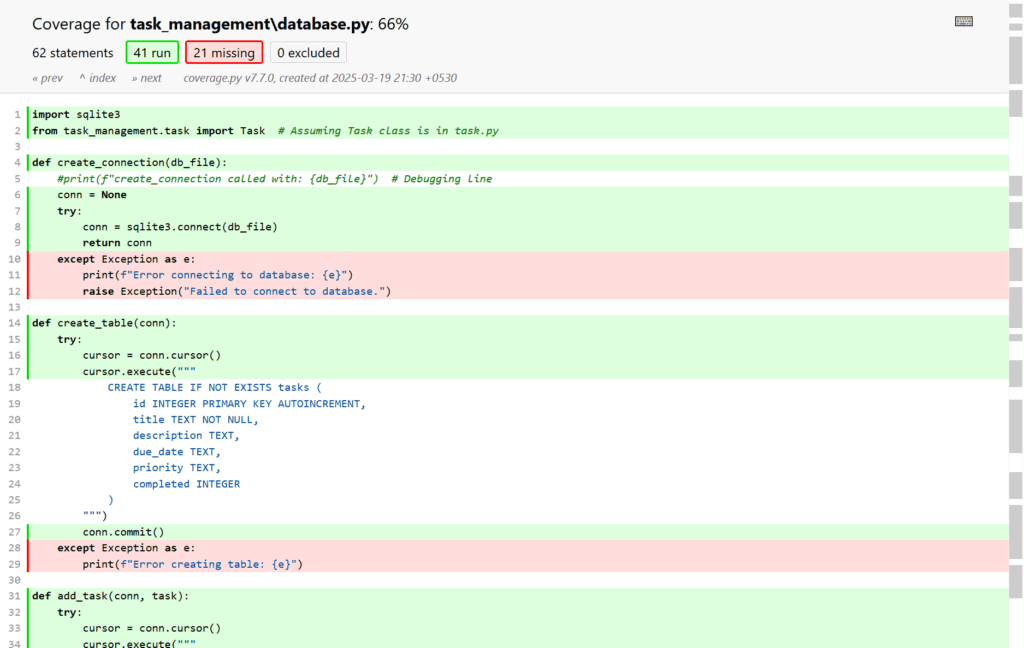
Why pytest Code Coverage Matters in Python?
Have you ever wondered if your Python package is fully tested and which parts remain uncovered? Ensuring comprehensive test coverage with pytest code is crucial for maintaining software reliability and preventing undetected issues.
In the ever-evolving landscape of software development, writing high-quality code and implementing efficient testing strategies are essential for delivering robust applications. One of the most effective tools to achieve this is pytest’s coverage reporting. Code coverage provides a quantitative measure of how thoroughly your test scripts validate your code, helping identify untested areas and potential risks.
In this blog post, we will explore the significance of pytest coverage, its impact on code quality, and how it can optimize your testing workflow for maximum efficiency.
Table of Contents
Efficient Testing with PyTest Code Coverage
Maximizing PyTest Code Coverage Effectiveness
Code Coverage Practical Example
What is PyTest Code Coverage?
PyTest is a powerful and widely used testing framework in Python, known for its simplicity and robust capabilities. When combined with the pytest-cov plugin, pytest-cov enables developers to measure how much of their code is exercised during testing.
Code coverage is a crucial metric that indicates the percentage of code executed by test cases, helping identify untested sections. By leveraging pytest-cov, developers gain actionable insights to improve test coverage, enhance application reliability, and ensure more robust software.
Why Code Coverage Matters
- ✅ Identify Untested Code: A code coverage report highlights untested sections of your codebase, ensuring that all critical functionalities are validated through comprehensive tests. This helps eliminate blind spots and improve software reliability.
- ✅ Enhance Confidence in Code Changes: In complex applications, even minor modifications can introduce unexpected issues. High code coverage provides a safety net, reducing the risk of regressions and giving developers confidence when making changes.
- ✅ Promote Better Code Quality: Writing thorough tests fosters modular and maintainable code. Well-tested code often adheres to best design practices, leading to cleaner, more efficient, and scalable implementations.
- ✅ Simplify Debugging: Knowing which parts of the code are covered by tests makes it easier to pinpoint and resolve issues. Code paths frequently exercised by tests are less prone to bugs, improving overall stability.
- ✅ Streamline Team Collaboration: Comprehensive test coverage serves as a form of documentation, helping new team members understand the codebase’s functionality and behavior more efficiently, ultimately enhancing team productivity.
Efficient Testing with pytest
PyTest coverage goes beyond just measuring test coverage—it actively enhances the testing process. Here’s how:
- ✅ Detailed Reports: The pytest-cov plugin generates comprehensive reports, breaking down coverage by file, class, and function. For example, if a specific function in your API remains untested, the report will highlight this gap, allowing for targeted improvements.
- ✅ Seamless CI/CD Integration: PyTest coverage integrates effortlessly with Continuous Integration/Continuous Deployment (CI/CD) pipelines. Automated coverage checks ensure consistent validation at every stage of development, minimizing manual oversight and catching issues early.
- ✅ Enforce Coverage Thresholds: Developers can define minimum coverage thresholds to prevent insufficiently tested code from being merged into production. For instance, enforcing a 90% coverage requirement ensures all modules meet a predefined quality standard before approval.
- ✅ Customizable Exclusions: Certain files or code sections—such as those generated by third-party libraries—may not require testing. PyTest coverage allows you to exclude these from reports, keeping your metrics focused on the most critical parts of your codebase.
Maximizing Coverage Effectiveness
To fully leverage pytest coverage, adopt these best practices:
- ✅ Prioritize Critical Code Paths
Firstly focus on testing the most important parts of your codebase, such as core business logic, API endpoints, and high-traffic features. For example, in an e-commerce platform, testing the checkout process and payment integration is more critical than rarely used settings pages. - ✅ Regularly Review Coverage Reports
Next, make code coverage reviews a routine part of your development and code review process. By identifying gaps early, you can address them proactively. Additionally, discussing coverage reports during code reviews helps teams identify untested areas and potential improvements before merging changes. - ✅ Combine Coverage with Other Quality Metrics
However, code coverage alone isn’t enough to ensure test effectiveness. Instead, pair it with other metrics like cyclomatic complexity (to measure code complexity), test execution time (to optimize performance), and mutation testing (for test robustness) for a comprehensive quality check. - ✅ Refactor When Necessary
Low coverage often indicates overly complex or tightly coupled code, which can be difficult to test. Therefore, use coverage insights to refactor and simplify functions, making them more modular, maintainable, and testable. As a result, cleaner code leads to higher reliability, easier debugging, and long-term stability.
Practical Example
Here’s a practical example demonstrating the use of PyTest and pytest-cov to test a real application.
Let’s measure the code coverarge for our Task Manager project developed in our pytest article.
To measure code coverage, run the following command in your terminal:
pytest --cov=task_management --cov-report=html tests/PS C:\enodeas\TaskManager> pytest --cov=task_management --cov-report=html tests/
======================== test session starts ========================
platform win32 -- Python 3.10.9, pytest-8.3.5, pluggy-1.5.0
rootdir: C:\enodeas\TaskManager
plugins: bdd-8.1.0, cov-6.0.0, html-4.1.1, metadata-3.1.1, mock-3.14.0, xdist-3.6.1, anyio-3.5.0
collected 13 items
tests\test_database.py ...... [ 46%]
tests\test_task_manager.py ....... [100%]
---------- coverage: platform win32, python 3.10.9-final-0 -----------
Coverage HTML written to dir htmlcov
======================= 13 passed, 2 warnings in 0.39s ===================== This will generate an HTML coverage report, making it easy to identify untested code. Navigate to htmlcov folder under root and open index.html file to see the coverage report.

Real-World Application
For instance, with the above example, you are developing a task management application that handles the user interface. While writing tests, a coverage report reveals that the user interface functionality is untested. By adding tests for this critical feature—including edge cases like task reports and ui—you not only improve coverage but also ensure that the application behaves as expected under all conditions. This proactive approach reduces the risk of critical failures in production.
For database.py 66% of code is tested by pytest. You can open the file(*_database_py.html) to see which part of the Python file is not properly tested.

In the above html file green highlighted are is tested but red part is not tested. So you can plan to add few test cases to cover the exception part so that 100% code will be covered.
Lesser Known Facts About pytest-cov
Here are some lesser-known facts about pytest-cov that can help you get the most out of it.
1. It Can Measure Branch Coverage
Most developers focus on statement coverage, but pytest-cov can also measure branch coverage, which ensures that all possible execution paths in conditional statements (if-else) are tested. Use –cov-branch to enable this feature.
2. You Can Combine Multiple Coverage Sources
If your project has multiple test suites (e.g., unit tests, integration tests, functional tests), you can merge coverage data across runs using:
pytest --cov=task_management --cov-report=xml --cov-appendPS C:\enodeas\TaskManager> pytest --cov=task_management --cov-report=xml --cov-append
====================== test session starts ====================
platform win32 -- Python 3.10.9, pytest-8.3.5, pluggy-1.5.0
rootdir: C:\enodeas\TaskManager
plugins: bdd-8.1.0, cov-6.0.0, html-4.1.1, metadata-3.1.1, mock-3.14.0, xdist-3.6.1, anyio-3.5.0
collected 13 items
tests\test_database.py ...... [ 46%]
tests\test_task_manager.py ....... [100%]
------- coverage: platform win32, python 3.10.9-final-0 --------
Coverage XML written to file coverage.xml
================ 13 passed, 2 warnings in 0.19s ================
This helps maintain a comprehensive coverage report across different test stages.
3. It Can Show Missing Line Numbers
Want to know exactly which lines are missing coverage? You need add “cov-report=term-missing” in the terminal command.
pytest --cov=task_management --cov-report=term-missing PS C:\enodeas\TaskManager> pytest --cov=task_management --cov-report=term-missing
======================= test session starts ======================
platform win32 -- Python 3.10.9, pytest-8.3.5, pluggy-1.5.0
rootdir: C:\enodeas\TaskManager
plugins: bdd-8.1.0, cov-6.0.0, html-4.1.1, metadata-3.1.1, mock-3.14.0, xdist-3.6.1, anyio-3.5.0
collected 13 items
tests\test_database.py ...... [ 46%]
tests\test_task_manager.py ....... [100%]
---------- coverage: platform win32, python 3.10.9-final-0 -----------
Name Stmts Miss Cover Missing
---------------------------------------------------------------
task_management\__init__.py 0 0 100%
task_management\config.py 2 0 100%
task_management\database.py 62 21 66% 10-12, 28-29, 40-42, 55-58, 73-75, 83-84, 87-90
task_management\storage.py 17 4 76% 10-11, 20-21
task_management\task.py 19 0 100%
task_management\task_manager.py 71 14 80% 14, 30, 59-69, 72, 77, 81
task_management\task_reports.py 21 21 0% 1-31
task_management\ui.py 34 34 0% 1-42
task_management\utils.py 2 0 100%
---------------------------------------------------------------
TOTAL 228 94 59%
====================== 13 passed, 2 warnings in 0.22s ====================== This displays missed line numbers directly in the terminal, making it easier to pinpoint gaps in your tests.
4. You Can Enforce Minimum Coverage to Prevent Merging Bad Code
To fail tests if coverage drops below a threshold, use:
pytest --cov=task_management--cov-fail-under=90
This prevents untested code from slipping into production.
5. It Supports Parallel Test Execution
Running coverage with pytest-xdist (-n auto) can significantly speed up tests by distributing them across multiple CPU cores. However, you need to ensure coverage data is properly merged:
pytest --cov=my_project --cov-report=xml -n autoPS C:\enodeas\TaskManager> pytest --cov=task_management --cov-report=xml -n auto
========================== test session starts ==========================
platform win32 -- Python 3.10.9, pytest-8.3.5, pluggy-1.5.0
rootdir: C:\enodeas\TaskManager
plugins: bdd-8.1.0, cov-6.0.0, html-4.1.1, metadata-3.1.1, mock-3.14.0, xdist-3.6.1, anyio-3.5.0
10 workers [13 items]
............. [100%]
---------- coverage: platform win32, python 3.10.9-final-0 -----------
Coverage XML written to file coverage.xml
==================== 13 passed, 20 warnings in 3.06s ====================6. You Can Exclude Specific Code Blocks
Certain parts of your code, like logging, debugging, or third-party dependencies, might not need coverage. You can exclude them using “pragma: no cover”.
#pragma: no cover
def debug_function():
print("This function is for debugging only.")This keeps your coverage metrics focused on important code.
7. It Works Seamlessly with GitHub Actions
Want to automate coverage reports in your CI/CD pipeline? Add pytest-cov to your GitHub Actions workflow and upload results to a coverage tracking service like Codecov or Coveralls.
Conclusion
PyTest coverage is more than a metric; it is an essential tool for fostering better development practices, reducing bugs, and ensuring long-term application maintainability. By incorporating pytest coverage into your workflow, you can enhance code quality and testing efficiency, creating a solid foundation for successful software projects.
Remember, achieving high coverage is not the end goal but a means to deliver reliable and maintainable code. With pytest coverage, you can build confidence in your tests, your code, and your team’s ability to deliver excellence.




Pingback: PyTest HTML Reporter: Generate Beautiful Report